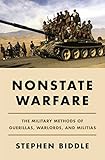Nonstate warfare : the military methods of guerillas, warlords, and militias
Material type: TextPublication details: Princeton University Press Princeton 2021Description: 436pISBN:
TextPublication details: Princeton University Press Princeton 2021Description: 436pISBN: - 9780691207513
- 355.0218 BID
| Item type | Current library | Collection | Call number | Status | Date due | Barcode | Item holds | |
|---|---|---|---|---|---|---|---|---|
 Book
Book
|
Jammu General Stacks | Non-fiction | 355.0218 BID (Browse shelf(Opens below)) | Available | IIMJ-5853 |
Browsing Jammu shelves, Shelving location: General Stacks, Collection: Non-fiction Close shelf browser (Hides shelf browser)
Table of Contents: The fallacy of guerilla warfare Materially optimal behaviour Politically achievable behavior Hezbollah in the 2006 Lebanon Campaign The Jaish al Mahdi in Iraq, 2003-2008 The Somali National Alliance in Somalia, 1992-1994 The ZNG, HV, and SVK in the Croatian Wars of Independence, 1991-1995 The Vietcong in the Second Indochina War, 1965-1968 Conclusion and implications.
Armed non-state actors have received increasing attention since September 11th, 2001, both from scholars and from policymakers and soldiers--and with this attention has come a vibrant debate about whether nonstate civil warfare and insurgency are the future of war, and if so, how it should be countered. Yet underlying these debates is one crucial shared assumption: that states and nonstate actors fight very differently. Biddle upturns this distinction in How Nonstate Actors Fight, examining actual military methods to show that many nonstate actors now fight more "conventionally" than many states. Rather than a dichotomy, Biddle frames nonstate and state methods along a continuum and presents a systematic theory to explain any given nonstate actor's position on this spectrum. His theory emphasizes how actors' internal politics - especially their institutional maturity and war aims - determine their military choices. In doing so, Biddle bridges two largely opposing groups of scholarship: materialists who assume that material and structural constraints will lead nonstates to prefer irregular warfare, and culturalists who see nonstate war-making as connected to social norms. Biddle integrates both materialist and cultural considerations into this theory but emphasizes internal politics as the chief determinant of how any actor will fight. The first four chapters present Biddle's theory and the next five tests are across a range of historical examples, from Lebanon to Iraq to Somalia to Croatia to the Vietcong
There are no comments on this title.








